-
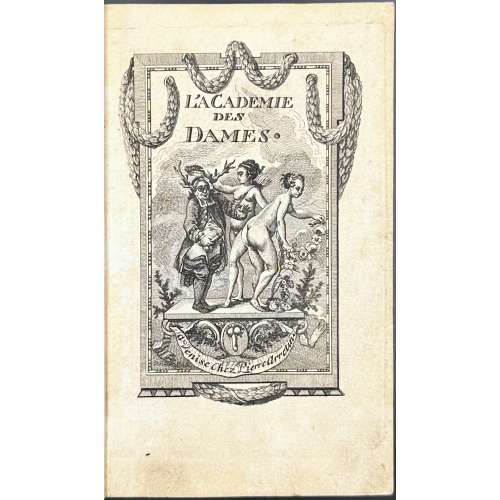 A set of two volumes, one with the text (1) and another with the plates (2), cased in a red ‘romantic’ fitting box of red morocco, lavishly tooled in gilt, c. 1840, more recently adapted to house two books of different size. Vol.1: Hardcover volume, 22.4 x 14 cm, 8vo, bound in half black polished calf (late 19th century) over marbled boards, spine and corners gilt-tooled, raised bands, gilt lozenges in compartments, gilt-lettered red morocco label; marbled endpapers; Francis M. G. Mauleverer armorial bookplate (motto “Deus Providebit”) to front pastedown. Printed on laid paper, Collation: 1 blank, engraved frontis., engraved t.p., A-Cc8 Dd2, 1 blank; pagination:[1] 2-420. Vol. 2: Hardcover volume, 21 x 14 cm, bound in green straight-grain morocco (early 19th century), boards with a roll-tooled palmette border, spine decorated in gilt, blue moiré endpapers, yellow feps, additional blank leaves: 2 in the front and 4 in the back, unpaginated; engraved frontis. and t.p. as in vol. 2, plus 35 plates now attributed to Delcroche printed on India paper, pasted on thicker leaves and bound in numerical order, but pl. 34 after pl. 35; As per Christie’s “The prints, sometimes attributed to de Hooghe, are actually by Delcroche, who illustrated a number of classics in the 1770s and 1780s, including Fanny Hill. AE and ABPC record only three copies of this edition at auction, including the Nordmann and Hayoit copies. Apollinaire Enfer, 277; Dutel A-15; Eros invaincu 16; Foxon Libertine Literature, NY: 1965, p.38; Gay-Lemonnyer I, 10; Pia Enfer, 346.” Contributors: Delcroche (Dutch, 17th century), “artiste hollandaise”, nothing else is known. Dutel and Nordmann attribute the plates to Romeyn de Hooghe (Dutch, 1645 – 1708). Nicolas Chorier (French, 1612 – 1692) – author. Francis M. G. Mauleverer (British, 1918 – 1962) – provenance. Seller’s description: 2 vols in 8vo (215x125 and 204x117 mm), a complete but composite set, the text volume in late 19th c. half black morocco, with corners, gilt spine tooled in gold, the plate volume in a nice early 19th-century green morocco binding, the spine gilt-tooled in compartments, the sides with a roll-tooled palmette border, pale blue moiré style endpapers (hinges repaired). Text vol.: engraved frontispiece, engr. title, pp. 420. Plates vol. comprising: the engraved title, frontispiece, and 35 engraved plates, probably by Delcroche. Both volumes cased in a ‘romantic’ fitting box binding, c. 1840, more recently adapted.
A set of two volumes, one with the text (1) and another with the plates (2), cased in a red ‘romantic’ fitting box of red morocco, lavishly tooled in gilt, c. 1840, more recently adapted to house two books of different size. Vol.1: Hardcover volume, 22.4 x 14 cm, 8vo, bound in half black polished calf (late 19th century) over marbled boards, spine and corners gilt-tooled, raised bands, gilt lozenges in compartments, gilt-lettered red morocco label; marbled endpapers; Francis M. G. Mauleverer armorial bookplate (motto “Deus Providebit”) to front pastedown. Printed on laid paper, Collation: 1 blank, engraved frontis., engraved t.p., A-Cc8 Dd2, 1 blank; pagination:[1] 2-420. Vol. 2: Hardcover volume, 21 x 14 cm, bound in green straight-grain morocco (early 19th century), boards with a roll-tooled palmette border, spine decorated in gilt, blue moiré endpapers, yellow feps, additional blank leaves: 2 in the front and 4 in the back, unpaginated; engraved frontis. and t.p. as in vol. 2, plus 35 plates now attributed to Delcroche printed on India paper, pasted on thicker leaves and bound in numerical order, but pl. 34 after pl. 35; As per Christie’s “The prints, sometimes attributed to de Hooghe, are actually by Delcroche, who illustrated a number of classics in the 1770s and 1780s, including Fanny Hill. AE and ABPC record only three copies of this edition at auction, including the Nordmann and Hayoit copies. Apollinaire Enfer, 277; Dutel A-15; Eros invaincu 16; Foxon Libertine Literature, NY: 1965, p.38; Gay-Lemonnyer I, 10; Pia Enfer, 346.” Contributors: Delcroche (Dutch, 17th century), “artiste hollandaise”, nothing else is known. Dutel and Nordmann attribute the plates to Romeyn de Hooghe (Dutch, 1645 – 1708). Nicolas Chorier (French, 1612 – 1692) – author. Francis M. G. Mauleverer (British, 1918 – 1962) – provenance. Seller’s description: 2 vols in 8vo (215x125 and 204x117 mm), a complete but composite set, the text volume in late 19th c. half black morocco, with corners, gilt spine tooled in gold, the plate volume in a nice early 19th-century green morocco binding, the spine gilt-tooled in compartments, the sides with a roll-tooled palmette border, pale blue moiré style endpapers (hinges repaired). Text vol.: engraved frontispiece, engr. title, pp. 420. Plates vol. comprising: the engraved title, frontispiece, and 35 engraved plates, probably by Delcroche. Both volumes cased in a ‘romantic’ fitting box binding, c. 1840, more recently adapted. -
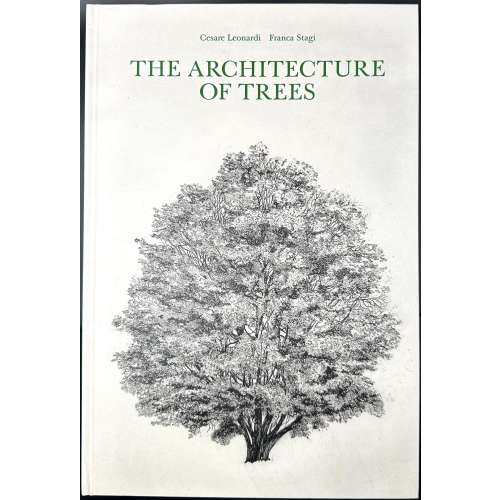 Hardcover volume, 38.3 x 26 x 3.8 cm, pictorial boards, lettering to front cover and spine, pp.: [1-6] 7-421 [3], ils. Title-page: Cesare Leonardi Franca Stagi | THE ARCHITECTURE | OF TREES | Introduction to the new edition | ANDREA CAVANI, GIULIO ORSINI | Translated from the Italian by | NATALIE DANFORD | Princeton Architectural Press | New York || Cesare Leonardi (Italian, 1935 – 2021) Franca Stagi (Italian, 1937 – 2008) Natalie Danford (American, b. 1968)
Hardcover volume, 38.3 x 26 x 3.8 cm, pictorial boards, lettering to front cover and spine, pp.: [1-6] 7-421 [3], ils. Title-page: Cesare Leonardi Franca Stagi | THE ARCHITECTURE | OF TREES | Introduction to the new edition | ANDREA CAVANI, GIULIO ORSINI | Translated from the Italian by | NATALIE DANFORD | Princeton Architectural Press | New York || Cesare Leonardi (Italian, 1935 – 2021) Franca Stagi (Italian, 1937 – 2008) Natalie Danford (American, b. 1968) -
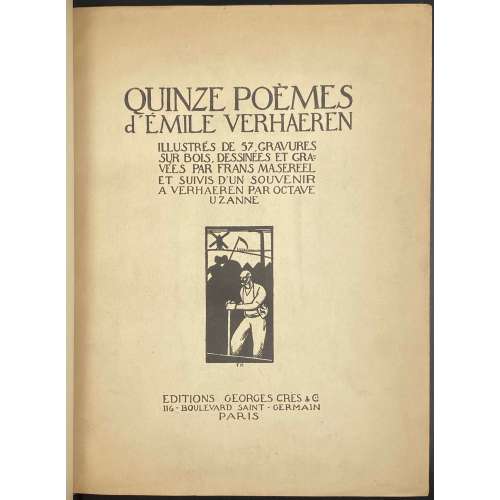 Quinze poèmes d'Emile Verhaeren. Illustrés de 57 gravures sur bois dessinées et gravées par Frans Masereel et suivis d'un 'Souvenir à Verhaeren' par Octave Uzanne. — Paris: Éditions Georges Crès, 1917. Authors: Emile Verhaeren (text), Frans Masereel (illustrations), Octave Uzanne (text). Publisher: Éditions Georges Crès. [Georges-Célestin Crès (1875 - 1935) was a French publisher and bookseller. Address: 116 boulevard Saint-Germain, Paris]. Printer: Sonor S.A. - Geneve, under the direction of Auguste Jordanis. The number of copies printed: 1555 of which 15 (1-15) on Japan paper, 190 (16-205) on Fabriano paper, and 1350 (206-1555) on English paper (1506-1555 not for trade). This copy № 1312. Pagination: [i] - front cover, [ii] - half-title, [iii] - title, [iv] - printrun justification, [v] - table of contents, [vi] - blank, [i-vii] viii-ciii, [civ] - printer statement, [cv] - back cover; one-side (recto) printing and pagination. Owner's contemporary red half-Morocco with marbled boards; spine with four raised bands, gilt lettering and design elements. Original printed paper wrappers preserved. Marbled endpapers. Trimmed unevenly.
Quinze poèmes d'Emile Verhaeren. Illustrés de 57 gravures sur bois dessinées et gravées par Frans Masereel et suivis d'un 'Souvenir à Verhaeren' par Octave Uzanne. — Paris: Éditions Georges Crès, 1917. Authors: Emile Verhaeren (text), Frans Masereel (illustrations), Octave Uzanne (text). Publisher: Éditions Georges Crès. [Georges-Célestin Crès (1875 - 1935) was a French publisher and bookseller. Address: 116 boulevard Saint-Germain, Paris]. Printer: Sonor S.A. - Geneve, under the direction of Auguste Jordanis. The number of copies printed: 1555 of which 15 (1-15) on Japan paper, 190 (16-205) on Fabriano paper, and 1350 (206-1555) on English paper (1506-1555 not for trade). This copy № 1312. Pagination: [i] - front cover, [ii] - half-title, [iii] - title, [iv] - printrun justification, [v] - table of contents, [vi] - blank, [i-vii] viii-ciii, [civ] - printer statement, [cv] - back cover; one-side (recto) printing and pagination. Owner's contemporary red half-Morocco with marbled boards; spine with four raised bands, gilt lettering and design elements. Original printed paper wrappers preserved. Marbled endpapers. Trimmed unevenly. -
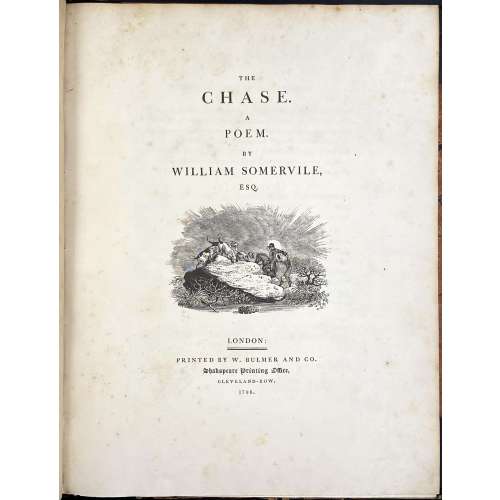 Royal 4to, 29.8 x 23.5 cm, contemporary half brown morocco, marbled boards gilt ruled, spine with gilt-ruled raised bands, gilt title lettering; "William Gore" armorial bookplate to front pastedown. Title page: THE | CHASE. | A | POEM. | BY | WILLIAM SOMERVILLE, | ESQ. | [VIGNETTE] | LONDON : | PRINTED BY W. BULMER AND CO. | Shakespeare Printing Office, | CLEVELAND-ROW. | 1796. Collation: without signatures. — Pagination: [i-v] vi-xv [xvi], [i] ii-vii [viii], [1-5] 6-126; illustrations: engraved title, 4 running titles, 4 headpieces, 4 tailpieces – 13 altogether, all drafted by John Bewick, 12 executed by Thomas Bewick and the last one by Charlton Nesbit. Catalogue Raisonné: Thomas Hugo. The Bewick Collector, vol. 1 (1866): p. 38, № 94: "The first edition... was printed in royal 4to". John Bewick made all the drawing on the blocks but was not able to execute the engravings himself "because of ill-health. They were engraved by Thomas Bewick, with the exception of the tail-piece at the end of the volume, which was engraved by Nesbit". Thomas Bewick (c. 11 August 1753 – 8 November 1828); John Bewick (1760 – 1795), the younger brother of Thomas, died at the age of 35. Christie's, who sold a similar copy on 29 Oct 2012, provides for the size 2°.
Royal 4to, 29.8 x 23.5 cm, contemporary half brown morocco, marbled boards gilt ruled, spine with gilt-ruled raised bands, gilt title lettering; "William Gore" armorial bookplate to front pastedown. Title page: THE | CHASE. | A | POEM. | BY | WILLIAM SOMERVILLE, | ESQ. | [VIGNETTE] | LONDON : | PRINTED BY W. BULMER AND CO. | Shakespeare Printing Office, | CLEVELAND-ROW. | 1796. Collation: without signatures. — Pagination: [i-v] vi-xv [xvi], [i] ii-vii [viii], [1-5] 6-126; illustrations: engraved title, 4 running titles, 4 headpieces, 4 tailpieces – 13 altogether, all drafted by John Bewick, 12 executed by Thomas Bewick and the last one by Charlton Nesbit. Catalogue Raisonné: Thomas Hugo. The Bewick Collector, vol. 1 (1866): p. 38, № 94: "The first edition... was printed in royal 4to". John Bewick made all the drawing on the blocks but was not able to execute the engravings himself "because of ill-health. They were engraved by Thomas Bewick, with the exception of the tail-piece at the end of the volume, which was engraved by Nesbit". Thomas Bewick (c. 11 August 1753 – 8 November 1828); John Bewick (1760 – 1795), the younger brother of Thomas, died at the age of 35. Christie's, who sold a similar copy on 29 Oct 2012, provides for the size 2°. -
![Адарюковъ В.Я. Добавленiя и исправленiя къ подробномусловарю русскихъ гравированныхъ портретовъ Д.А.Ровинскаго, СПб. 1889. — Издание журнала "Старые годы", 1911. — 89 стр. [Владимир Яковлевич Адарюков (1863 -1932). Добавления и исправления к подробному словарю русских гравированных портретов Д.А.Ровинскаго].](https://varshavskycollection.com/wp-content/uploads/2021/02/LIB-1612-a-scaled-500x500.jpg) Title: В. Я. АДАРЮКОВЪ. | ДОБАВЛЕНIЯ И ИСПРАВЛЕНIЯ КЪ ПОДРОБНОМУ СЛОВАРЮ | РУССКИХЪ | ГРАВИРОВАННЫХЪ ПОРТРЕТОВЪ Д. А. РОВИНСКАГО | СПБ. 1889 г. | ИЗДАНИЕ ЖУРНАЛА «СТАРЫЕ ГОДЫ» | 1911. Pagination: [1-4] – incl. orig. wrappers with engraved vignette, 5-89 [90 blank], illustr. Size: 27 x 18.7 cm. Binding: Hardcover; owner's half brown buckram over cloth, original wrappers bound in. Printed on laid paper. Edition: 1st edition, limited: №91 of 150. Inscription to t.p.: Крамарев, 27.5.39. Errata inserts on p. 29 and 77
Title: В. Я. АДАРЮКОВЪ. | ДОБАВЛЕНIЯ И ИСПРАВЛЕНIЯ КЪ ПОДРОБНОМУ СЛОВАРЮ | РУССКИХЪ | ГРАВИРОВАННЫХЪ ПОРТРЕТОВЪ Д. А. РОВИНСКАГО | СПБ. 1889 г. | ИЗДАНИЕ ЖУРНАЛА «СТАРЫЕ ГОДЫ» | 1911. Pagination: [1-4] – incl. orig. wrappers with engraved vignette, 5-89 [90 blank], illustr. Size: 27 x 18.7 cm. Binding: Hardcover; owner's half brown buckram over cloth, original wrappers bound in. Printed on laid paper. Edition: 1st edition, limited: №91 of 150. Inscription to t.p.: Крамарев, 27.5.39. Errata inserts on p. 29 and 77 -
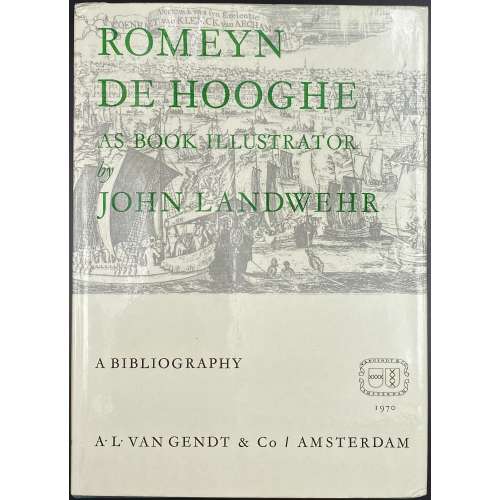 Title page: JOHN LANDWEHR | ROMEYN DE HOOGHE | (1645-1708) | AS BOOK ILLUSTRATOR | A BIBLIOGRAPHY | {space} | 1970 | AMSTERDAM: VANGENDT & CO | NEW YORK: ABNER SCHRAM || Pagination: [1-6] 7-247 [248 blank], ils. Content:109 entries, concordance table and 12 pp. of indices. Binding: 27.3 x 19.7 cm, green cloth, silver lettering to spine, pictorial dust jacket. ISBN: 90 6300 467 2. Contributors: Romeyn de Hooghe (Dutch, 1645 – 1708) John Landwehr – author.
Title page: JOHN LANDWEHR | ROMEYN DE HOOGHE | (1645-1708) | AS BOOK ILLUSTRATOR | A BIBLIOGRAPHY | {space} | 1970 | AMSTERDAM: VANGENDT & CO | NEW YORK: ABNER SCHRAM || Pagination: [1-6] 7-247 [248 blank], ils. Content:109 entries, concordance table and 12 pp. of indices. Binding: 27.3 x 19.7 cm, green cloth, silver lettering to spine, pictorial dust jacket. ISBN: 90 6300 467 2. Contributors: Romeyn de Hooghe (Dutch, 1645 – 1708) John Landwehr – author.Van Gendt & Co. (Amsterdam) – publisher.
Abner Schram Ltd. (NY) – publisher. -
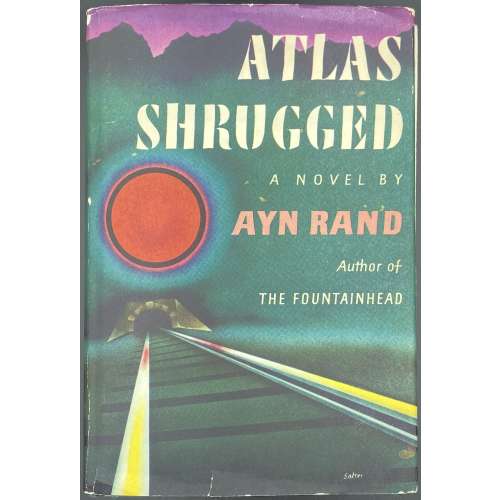 ATLAS | SHRUGGED | AYN RAND | {Publisher's device} | RANDOM HOUSE | NEW YORK || Pagination: [2] - h.t. / advert., [2] – t.p. / colophon, [2] – dedication / blank, [2] – contents / cont., [1, 2] ¬ f.t. / blank, [3] 4-1168 [1169] blank, [1170/71] about the author [1172] blank, two blank leaves. Original green cloth with gilt lettering, black label with gilt lettering and publisher device to spine; top margin green, lateral margin untrimmed. Stated first edition, first printing. Original dust jacket with $6.95 printed price and 10/57 code present on the front flap.
ATLAS | SHRUGGED | AYN RAND | {Publisher's device} | RANDOM HOUSE | NEW YORK || Pagination: [2] - h.t. / advert., [2] – t.p. / colophon, [2] – dedication / blank, [2] – contents / cont., [1, 2] ¬ f.t. / blank, [3] 4-1168 [1169] blank, [1170/71] about the author [1172] blank, two blank leaves. Original green cloth with gilt lettering, black label with gilt lettering and publisher device to spine; top margin green, lateral margin untrimmed. Stated first edition, first printing. Original dust jacket with $6.95 printed price and 10/57 code present on the front flap. -
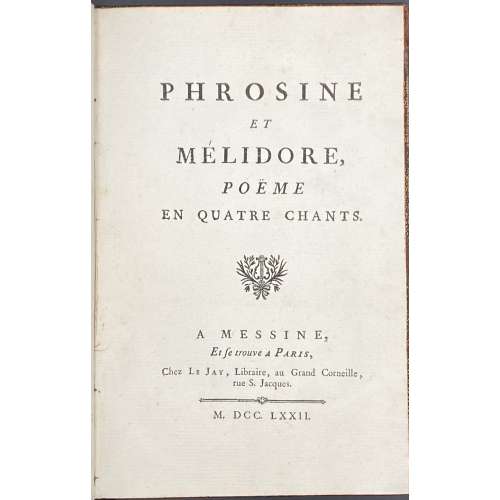 Title page: PHROSINE | ET | MELIDORE, | POËME | EN QUATRE CHANTS. | A MESSINE, | Et se trouve A Paris, | Chez Le Jay, Libraire, au Grand Corneille, | rue S. Jacques. | M. DCC. LXXII. || Pagination : ffl, [2] – h.t. / blank, [2] t.p. / blank, [1] 2-55 [56 blank], bfl ; 4 copperplate engravings by Nicolas Ponce (French, 1746 – 1831) after Charles Eisen (French, 1720 – 1778), one before each chant. Collation: 8vo; π2 (h.t., t.p. ) A-C8 D4. Binding: 20.5 x 14 cm, full mottled calf, gilt-ruled with triple fillet, flat spine, gilt in compartments, black label with gilt lettering, printed on laid paper, all edges red. Catalogue raisonné: Cohen de Ricci p. 132; J. Lewine: p. 53. Contributors: Nicolas Ponce (French, 1746 – 1831) Jean Charles Baquoy (French, 1721–1777) Charles-Dominique-Joseph Eisen (French, 1720 – 1778) Pierre-Joseph Bernard [Gentil-Bernard] (French, 1708 – 1775).
Title page: PHROSINE | ET | MELIDORE, | POËME | EN QUATRE CHANTS. | A MESSINE, | Et se trouve A Paris, | Chez Le Jay, Libraire, au Grand Corneille, | rue S. Jacques. | M. DCC. LXXII. || Pagination : ffl, [2] – h.t. / blank, [2] t.p. / blank, [1] 2-55 [56 blank], bfl ; 4 copperplate engravings by Nicolas Ponce (French, 1746 – 1831) after Charles Eisen (French, 1720 – 1778), one before each chant. Collation: 8vo; π2 (h.t., t.p. ) A-C8 D4. Binding: 20.5 x 14 cm, full mottled calf, gilt-ruled with triple fillet, flat spine, gilt in compartments, black label with gilt lettering, printed on laid paper, all edges red. Catalogue raisonné: Cohen de Ricci p. 132; J. Lewine: p. 53. Contributors: Nicolas Ponce (French, 1746 – 1831) Jean Charles Baquoy (French, 1721–1777) Charles-Dominique-Joseph Eisen (French, 1720 – 1778) Pierre-Joseph Bernard [Gentil-Bernard] (French, 1708 – 1775). -
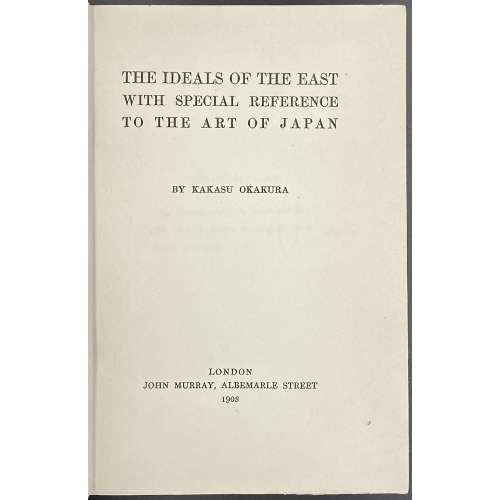 Title: THE IDEALS OF THE EAST | WITH SPECIAL REFERENCE | TO THE ART OF JAPAN | BY KAKASU OKAKURA | LONDON | JOHN MURRAY, ALBEMARLE STREET | 1903 || Collation: 8vo; ffl, [2] (t.p., prep. note) [a]4 b4, A-P8 Q4. Pagination: ffl, [I, ii] – h.t. / blank, [iii, iv] – t.p. / blank, [v, vi] – preparatory note / blank, vii-xxii, [1] 2-244, [1] 2-4 (Works for art lovers). Binding: Burgundy cloth, red flowers and lettering to cover, gilt lettering to spine. Size: 19.5 x 13 cm Contributors: Author: Okakura Kakuzō [岡倉 覚三] (1863 – 1913). Publisher: Murray, Sir John IV (1851–1928); John Murray (publishing house). Printer: Ballantyne, Hanson & Co., Edinburgh, London.
Title: THE IDEALS OF THE EAST | WITH SPECIAL REFERENCE | TO THE ART OF JAPAN | BY KAKASU OKAKURA | LONDON | JOHN MURRAY, ALBEMARLE STREET | 1903 || Collation: 8vo; ffl, [2] (t.p., prep. note) [a]4 b4, A-P8 Q4. Pagination: ffl, [I, ii] – h.t. / blank, [iii, iv] – t.p. / blank, [v, vi] – preparatory note / blank, vii-xxii, [1] 2-244, [1] 2-4 (Works for art lovers). Binding: Burgundy cloth, red flowers and lettering to cover, gilt lettering to spine. Size: 19.5 x 13 cm Contributors: Author: Okakura Kakuzō [岡倉 覚三] (1863 – 1913). Publisher: Murray, Sir John IV (1851–1928); John Murray (publishing house). Printer: Ballantyne, Hanson & Co., Edinburgh, London. -
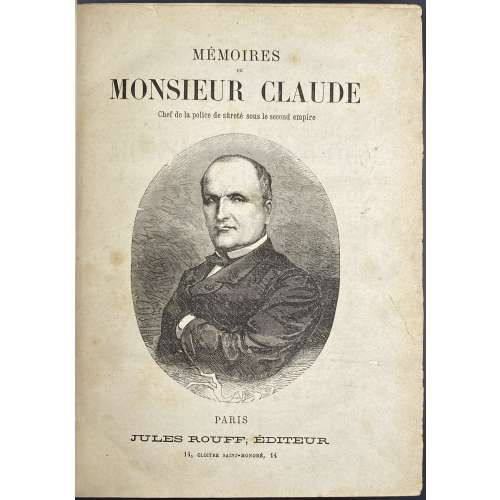 Vol. 1: Title: MÉMOIRES | DE | MONSIEUR CLAUDE | CHEF DE LA POLICE DE SURETÉ́ SOUS LE SECOND EMPIRE | {single rule} | PREMIER VOLUME | publisher’s device «JR» in oval} | PARIS | JULES ROUFF ET Cie, ÉDITEURS | 14, CLOITRE SAINT-HONORÉ, 14 | {single rule} || Pagination: [4] – h.t., t.p., [1-3] – engraved t.p. w/portrait, 3-800 [4], in-text and full-page woodcuts; last two leaves (table) has numbered pages 1000 and 1001; the total number of pages 808. Collation: 4to; π2 [1]4 2-1004 Ω2, woodcuts by Quesnel and Ferdinandus, within collation; the total number of leaves 404. Vol. 2: Title: Same but “DEUXIEME VOLUME” Pagination: [4] – h.t., t.p., [801-2] – frontis., 803-2010, [6] – assassinats, [4] – table, in-text and full-page woodcuts; last two leaves (table) has numbered pages 2018 and 2019; the total number of pages 1224. Collation: 4to; π2 101-2524 Ω2, woodcuts by Quesnel and Ferdinandus, within collation; the total number of leaves 612. Binding: Two volumes 28 x 20.5 cm each, uniformly bound in quarter polished brown calf over marbled boards, blind-stamped florets and gilt lettering to spine, marbled endpapers. Contributors: Claude, Antoine (French, 1807 – 1880) – declared author of the text. Labourieu, Théodore (French, 1822 – 1889) – assumed author of the text. Quesnel, Désiré Mathieu (French, 1843 – 1915) – woodcut printmaker. Ferdinandus, Alexandre [Avenet, François] (French, 1850 – 1888) – illustrator. D. Bardin et Cie – printer. Jules Rouff (French, 1846 – 1927) – publisher. Jules Rouff et Cie (Paris, 1873 – 1982) – publisher. Note: Common opinion is that the text was produced by Théodore Labourieu, not by, Antoine Claude. The first edition was published by the same publisher in 10 volumes in wrappers without illustrations, between 1880 and 1883, after the death of Antoine Claude. As stated in WorldCat: “not written or sanctioned by him.” This two-volume edition was published later, with multiple woodcuts.
Vol. 1: Title: MÉMOIRES | DE | MONSIEUR CLAUDE | CHEF DE LA POLICE DE SURETÉ́ SOUS LE SECOND EMPIRE | {single rule} | PREMIER VOLUME | publisher’s device «JR» in oval} | PARIS | JULES ROUFF ET Cie, ÉDITEURS | 14, CLOITRE SAINT-HONORÉ, 14 | {single rule} || Pagination: [4] – h.t., t.p., [1-3] – engraved t.p. w/portrait, 3-800 [4], in-text and full-page woodcuts; last two leaves (table) has numbered pages 1000 and 1001; the total number of pages 808. Collation: 4to; π2 [1]4 2-1004 Ω2, woodcuts by Quesnel and Ferdinandus, within collation; the total number of leaves 404. Vol. 2: Title: Same but “DEUXIEME VOLUME” Pagination: [4] – h.t., t.p., [801-2] – frontis., 803-2010, [6] – assassinats, [4] – table, in-text and full-page woodcuts; last two leaves (table) has numbered pages 2018 and 2019; the total number of pages 1224. Collation: 4to; π2 101-2524 Ω2, woodcuts by Quesnel and Ferdinandus, within collation; the total number of leaves 612. Binding: Two volumes 28 x 20.5 cm each, uniformly bound in quarter polished brown calf over marbled boards, blind-stamped florets and gilt lettering to spine, marbled endpapers. Contributors: Claude, Antoine (French, 1807 – 1880) – declared author of the text. Labourieu, Théodore (French, 1822 – 1889) – assumed author of the text. Quesnel, Désiré Mathieu (French, 1843 – 1915) – woodcut printmaker. Ferdinandus, Alexandre [Avenet, François] (French, 1850 – 1888) – illustrator. D. Bardin et Cie – printer. Jules Rouff (French, 1846 – 1927) – publisher. Jules Rouff et Cie (Paris, 1873 – 1982) – publisher. Note: Common opinion is that the text was produced by Théodore Labourieu, not by, Antoine Claude. The first edition was published by the same publisher in 10 volumes in wrappers without illustrations, between 1880 and 1883, after the death of Antoine Claude. As stated in WorldCat: “not written or sanctioned by him.” This two-volume edition was published later, with multiple woodcuts. -
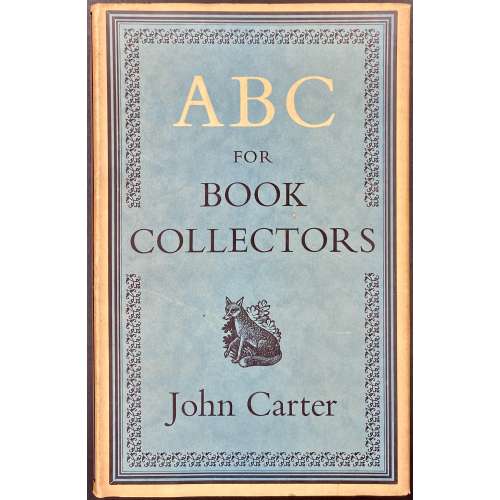 Title: ABC | FOR | BOOK-COLLECTORS | BY | JOHN CARTER | {publisher’s device} | RUPERT HART-DAVIS | SOHO SQUARE LONDON | 1952 | [TITLE-PAGE] || Pagination: [1-6] 7-191 [192 advert.], total number of pages 192. Collation: 8vo; [A]8 B-M8, total number of leaves 96. Binding: 21 x 13.5 cm, aubergine cloth, gilt lettering to spine, pictorial endpapers; cream unclipped (15s. net) dust-jacket with the sea-green panel in a border, with a fleuron frame, black and cream lettering, and publisher’s device to front; lettering to spine and back; folded prospectus insert loose. Edition: 1st. Contributors: Carter, John Waynflete (British, 1905 – 1975) – author Hart-Davis, Sir Rupert Charles (British, 1907 – 1999); Rupert Hart-Davis Ltd. (London) – publisher. Hazell, Watson and Viney, Ltd. – printer.
Title: ABC | FOR | BOOK-COLLECTORS | BY | JOHN CARTER | {publisher’s device} | RUPERT HART-DAVIS | SOHO SQUARE LONDON | 1952 | [TITLE-PAGE] || Pagination: [1-6] 7-191 [192 advert.], total number of pages 192. Collation: 8vo; [A]8 B-M8, total number of leaves 96. Binding: 21 x 13.5 cm, aubergine cloth, gilt lettering to spine, pictorial endpapers; cream unclipped (15s. net) dust-jacket with the sea-green panel in a border, with a fleuron frame, black and cream lettering, and publisher’s device to front; lettering to spine and back; folded prospectus insert loose. Edition: 1st. Contributors: Carter, John Waynflete (British, 1905 – 1975) – author Hart-Davis, Sir Rupert Charles (British, 1907 – 1999); Rupert Hart-Davis Ltd. (London) – publisher. Hazell, Watson and Viney, Ltd. – printer. -
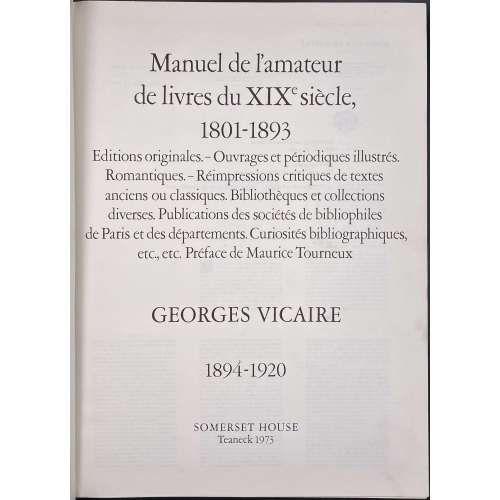 Title-page: Manuel de l'amateur | de livres du XIXe siècle, | 1801 - 1893 | Editions originales – Ouvrages et périodiques illustrés. | Romantiques – Réimpressions critiques de textes | anciens ou classiques. Bibliothèques et collections | diverses. Publications des sociétés de bibliophiles | de Paris et des départements. Curiosités bibliographiques, | etc., etc. Préface de Maurice Tourneux. | GEORGES VICAIRE | 1894-1920 | SOMERSET HOUSE | Teaneck 1973 || Photographically reduced reprint in one volume of the original edition by A. Rouquette (Paris) in 8 volumes, 9 pages to a page. Vol. 1: xix, 990; Vol. 2: 1098; Vol. 3: 1188; Vol. 4: 1362; Vol. 5: 1324; Vol. 6: 1240; Vol. 7: 1232; Vol. 8: Index of titles – 646; 4,559 original physical pages total (two numbers for one physical page). Binding: Green cloth, glit lettering to spine, 36 x 26 cm. Contributors: Georges Vicaire (French, 1853 – 1921) Maurice Tourneux (French, 1849 – 1917)
Title-page: Manuel de l'amateur | de livres du XIXe siècle, | 1801 - 1893 | Editions originales – Ouvrages et périodiques illustrés. | Romantiques – Réimpressions critiques de textes | anciens ou classiques. Bibliothèques et collections | diverses. Publications des sociétés de bibliophiles | de Paris et des départements. Curiosités bibliographiques, | etc., etc. Préface de Maurice Tourneux. | GEORGES VICAIRE | 1894-1920 | SOMERSET HOUSE | Teaneck 1973 || Photographically reduced reprint in one volume of the original edition by A. Rouquette (Paris) in 8 volumes, 9 pages to a page. Vol. 1: xix, 990; Vol. 2: 1098; Vol. 3: 1188; Vol. 4: 1362; Vol. 5: 1324; Vol. 6: 1240; Vol. 7: 1232; Vol. 8: Index of titles – 646; 4,559 original physical pages total (two numbers for one physical page). Binding: Green cloth, glit lettering to spine, 36 x 26 cm. Contributors: Georges Vicaire (French, 1853 – 1921) Maurice Tourneux (French, 1849 – 1917) -
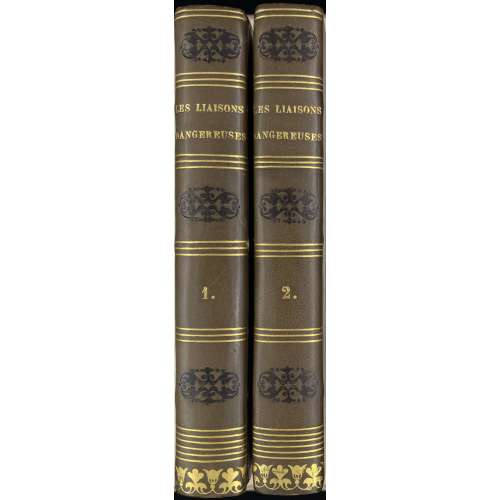 [Choderlos de Laclos.] Les Liaisons dangereuses, lettres recueillies dans une société, et publiées pour l’instruction de quelques autres; par M. C*** de L*** / Ornées de 6 gravures d'après Devéria. — Londres: s.n., 1820. Description: two volumes, collated 12mo, 17.1 x 10.6 cm each, modern binding – recently bound in quarter brown calf with gilt lettering, fillets and black fleurons to spine over green marbled boards; bookplate to front pastedown in each volume: “Ex-Libris | F.-M. Caye”. Printed on laid paper, each volume is illustrated with a frontispiece and two plates engraved by various engravers after Achille Devéria under the direction of Ambroise Tardieu. Title-page: LES LIAISONS | DANGEREUSES, | LETTRES RECUEILLIES | DANS UNE SOCIÉTÉ, | ET PUBLIÉES POUR L’INSTRUCTION DE QUELQUES AUTRES. | PAR M. C*** DE L***. | {3 lines of citation from J.-J. Rousseau} | TOME PREMIER (TOME SECOND) | — | A LONDRES. | ~ | M.D.CCC.XX. || Collation: Vol. 1: π8 1-1412 156, total 182 leaves plus 3 engraved plates: frontispiece and opposite to pp. 37 and 338. Pagination: [1-5] 6-16, [1] 2-348, total 364 pages. Vol. 2: π2 16 2-1512 162, total 178 leaves plus 3 engraved plates: frontispiece and opposite to pp. 25 and 316. Pagination: [4] [1] 2-352, total 356 pages. Provenance: Caye, F.-M. Pierre Ambroise François Choderlos de Laclos (French, 1741 – 1803) – author. Achille Jacques-Jean-Marie Devéria (French, 1800 – 1857) – artist. Engravers: Ambroise Tardieu (French, 1788 – 1841) Jean Baptiste Touzé (French, fl. 1810 – 1830) Jean Jacques Frilley (French, 1797 – after 1850) Achille Lefèvre (French, 1798 – 1864) Jean Louis Toussaint Caron (French, 1790 – 1832)
[Choderlos de Laclos.] Les Liaisons dangereuses, lettres recueillies dans une société, et publiées pour l’instruction de quelques autres; par M. C*** de L*** / Ornées de 6 gravures d'après Devéria. — Londres: s.n., 1820. Description: two volumes, collated 12mo, 17.1 x 10.6 cm each, modern binding – recently bound in quarter brown calf with gilt lettering, fillets and black fleurons to spine over green marbled boards; bookplate to front pastedown in each volume: “Ex-Libris | F.-M. Caye”. Printed on laid paper, each volume is illustrated with a frontispiece and two plates engraved by various engravers after Achille Devéria under the direction of Ambroise Tardieu. Title-page: LES LIAISONS | DANGEREUSES, | LETTRES RECUEILLIES | DANS UNE SOCIÉTÉ, | ET PUBLIÉES POUR L’INSTRUCTION DE QUELQUES AUTRES. | PAR M. C*** DE L***. | {3 lines of citation from J.-J. Rousseau} | TOME PREMIER (TOME SECOND) | — | A LONDRES. | ~ | M.D.CCC.XX. || Collation: Vol. 1: π8 1-1412 156, total 182 leaves plus 3 engraved plates: frontispiece and opposite to pp. 37 and 338. Pagination: [1-5] 6-16, [1] 2-348, total 364 pages. Vol. 2: π2 16 2-1512 162, total 178 leaves plus 3 engraved plates: frontispiece and opposite to pp. 25 and 316. Pagination: [4] [1] 2-352, total 356 pages. Provenance: Caye, F.-M. Pierre Ambroise François Choderlos de Laclos (French, 1741 – 1803) – author. Achille Jacques-Jean-Marie Devéria (French, 1800 – 1857) – artist. Engravers: Ambroise Tardieu (French, 1788 – 1841) Jean Baptiste Touzé (French, fl. 1810 – 1830) Jean Jacques Frilley (French, 1797 – after 1850) Achille Lefèvre (French, 1798 – 1864) Jean Louis Toussaint Caron (French, 1790 – 1832) -
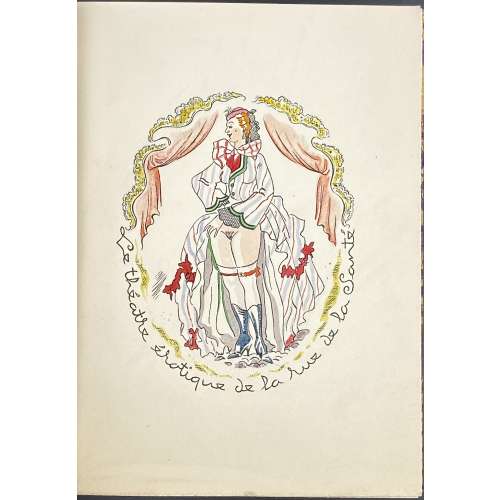 Description: Hardcover small 4to, 20.3 x 15.8 cm, contemporary binding, quarter carrot morocco with raised bands over marbled boards, marbled endpapers, original wrappers preserved, gilt lettering to spine. Content: Scapin Maquereau, drame en un acte par M. Albert Glatigny; La grisette et l’étudiant, pièce en un acte par M. Henry Monnier; Le bout de l’an de la noce, parodie du bout de l’an de l’amour de M. Théodore Barrière par MM. Lemercier de Neuville et J. du Boys; Un caprice par Lemercier de Neuville; Les jeux de l’amour et du bazar, comédie de mœurs en un acte par Lemercier de Neuville. Title-page: LE THÉATRE ÉROTIQUE | DE LA RUE DE LA SANTE | {vignette} | PARIS | — | 1932 || Collation: 3 blanks, original front wrapper with black lettering «LE THÉATRE ÉROTIQUE | DE LA RUE DE LA SANTE», [1]4 (2 blanks, frontis., h.t. / limitation), [2]4 (t.p., f.t.p., 2 leaves of text), 3-184 (incl. 2 blanks), original back wrapper, original spine, 3 blanks; 5 full-page illustrations within collation, 3 original watercolours extraneous to collation bound in between 11 and 12 blank leaves. Pagination: [4] [1-8] 9-135 [136] [4], ils. Limitation: 20 copies on Japon and 250 copies on Vélin, this is copy № 201. Edition: 1st edition thus, illustrated with 20 coloured photogravures, 5 of them full-page after Feodor Rojankovsky [Rojan], enriched with 3 full-page original watercolours by him. Catalogue raisonné: Dutel (1920-1970): 2498, p. 385; Nordmann/Christie’s (2) 515, p. 251 Contributors: Feodor Rojankovsky [Rojan, Фёдор Степанович Рожанковский] (Russian-American, 1891 – 1970) – artist. Joseph Albert Alexandre Glatigny (French, 1839 – 1873) – author. Henry-Bonaventure Monnier (French, 1799 – 1877) – author. Théodore Barrière (French, 1823 – 1877) – author. Louis Lemercier de Neuville [La Haudussière, Louis Lemercier] (French, 1830 – 1918) – author. Jean Charles Duboys [Du Boys] (French, 1836 – 1873) – author. Original watercolours:
Description: Hardcover small 4to, 20.3 x 15.8 cm, contemporary binding, quarter carrot morocco with raised bands over marbled boards, marbled endpapers, original wrappers preserved, gilt lettering to spine. Content: Scapin Maquereau, drame en un acte par M. Albert Glatigny; La grisette et l’étudiant, pièce en un acte par M. Henry Monnier; Le bout de l’an de la noce, parodie du bout de l’an de l’amour de M. Théodore Barrière par MM. Lemercier de Neuville et J. du Boys; Un caprice par Lemercier de Neuville; Les jeux de l’amour et du bazar, comédie de mœurs en un acte par Lemercier de Neuville. Title-page: LE THÉATRE ÉROTIQUE | DE LA RUE DE LA SANTE | {vignette} | PARIS | — | 1932 || Collation: 3 blanks, original front wrapper with black lettering «LE THÉATRE ÉROTIQUE | DE LA RUE DE LA SANTE», [1]4 (2 blanks, frontis., h.t. / limitation), [2]4 (t.p., f.t.p., 2 leaves of text), 3-184 (incl. 2 blanks), original back wrapper, original spine, 3 blanks; 5 full-page illustrations within collation, 3 original watercolours extraneous to collation bound in between 11 and 12 blank leaves. Pagination: [4] [1-8] 9-135 [136] [4], ils. Limitation: 20 copies on Japon and 250 copies on Vélin, this is copy № 201. Edition: 1st edition thus, illustrated with 20 coloured photogravures, 5 of them full-page after Feodor Rojankovsky [Rojan], enriched with 3 full-page original watercolours by him. Catalogue raisonné: Dutel (1920-1970): 2498, p. 385; Nordmann/Christie’s (2) 515, p. 251 Contributors: Feodor Rojankovsky [Rojan, Фёдор Степанович Рожанковский] (Russian-American, 1891 – 1970) – artist. Joseph Albert Alexandre Glatigny (French, 1839 – 1873) – author. Henry-Bonaventure Monnier (French, 1799 – 1877) – author. Théodore Barrière (French, 1823 – 1877) – author. Louis Lemercier de Neuville [La Haudussière, Louis Lemercier] (French, 1830 – 1918) – author. Jean Charles Duboys [Du Boys] (French, 1836 – 1873) – author. Original watercolours: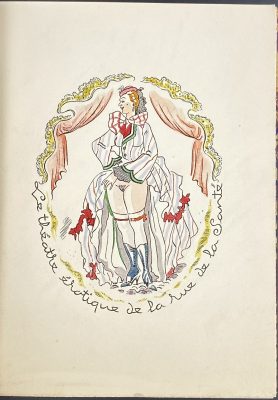

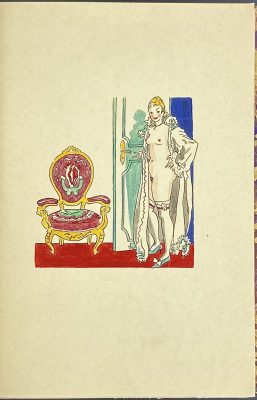
-
 Gustave Macé. La Police parisienne. Le vilain monde. Les dépeceurs de cadavres. Gibier de Saint-Lazare — Paris: Librairie illustrée, [1889]. Title-page: LA | POLICE PARISIENNE |—| LE VILAIN MONDE |—| LES DEPECEURS DE CADAVRES |—| GIBIER DE SAINT-LAZARE |—| Par | G. MACE | ANCIEN CHEF DE LA POLICE DE SURETÉ | {publisher’s device} | PARIS | LIBRAIRIE ILLUSTRÉE | 8, RUE SAINT-JOSEPH, 8 || Description: Hardcover, 4to, 28 x 20 cm, quarter green calf over green marbled boards, raised bands, gilt lettering and gilt fillets to spine, marbled endpapers. Collation:1st bank, [π2 h.t., t.p.], [1]-1074 [108]2 table, last blank; total 432 leaves; 107 woodcuts by Puyplat after E. Mas (on the recto of the first leaf of each complete gathering). Pagination: [4] [1-3] 4-859 [860]; total 864 pp. Edition: Later edition, probably 1889; the 1st edition was published in 1885. Contributors: Gustave Macé (French, 1835 – 1904) – author. Émile Mas (French, 1866 – 1950) – artist. Jules Jacques Puyplat (French, fl. c. 1877 – 1893) – engraver.
Gustave Macé. La Police parisienne. Le vilain monde. Les dépeceurs de cadavres. Gibier de Saint-Lazare — Paris: Librairie illustrée, [1889]. Title-page: LA | POLICE PARISIENNE |—| LE VILAIN MONDE |—| LES DEPECEURS DE CADAVRES |—| GIBIER DE SAINT-LAZARE |—| Par | G. MACE | ANCIEN CHEF DE LA POLICE DE SURETÉ | {publisher’s device} | PARIS | LIBRAIRIE ILLUSTRÉE | 8, RUE SAINT-JOSEPH, 8 || Description: Hardcover, 4to, 28 x 20 cm, quarter green calf over green marbled boards, raised bands, gilt lettering and gilt fillets to spine, marbled endpapers. Collation:1st bank, [π2 h.t., t.p.], [1]-1074 [108]2 table, last blank; total 432 leaves; 107 woodcuts by Puyplat after E. Mas (on the recto of the first leaf of each complete gathering). Pagination: [4] [1-3] 4-859 [860]; total 864 pp. Edition: Later edition, probably 1889; the 1st edition was published in 1885. Contributors: Gustave Macé (French, 1835 – 1904) – author. Émile Mas (French, 1866 – 1950) – artist. Jules Jacques Puyplat (French, fl. c. 1877 – 1893) – engraver. -
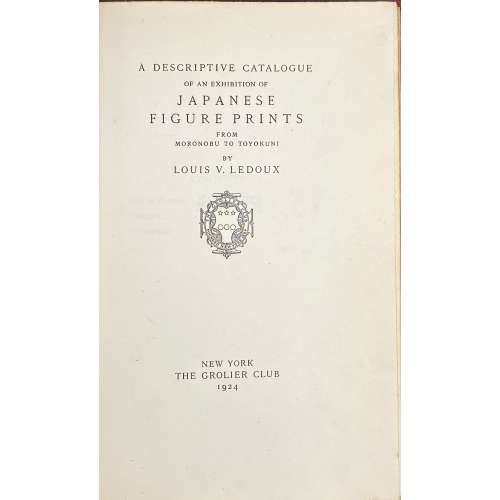 Hardcover, 24 x 16 cm, bound in quarter black calf over marbled boards, raised bands and gilt lettering to spine, printed on Van Gelder Zonen laid paper with wide margins, bottom and fore edge untrimmed, pp. [i-viii] ix-xiv, [2] 3-89 [90], total 104 pages, two flyleaves, frontispiece in colour with captioned tissue guard, and 28 b/w plates; total 83 leaves. Title-page: A DESCRIPTIVE CATALOGUE | OF AN EXHIBITION OF | JAPANESE | FIGURE PRINTS | FROM | MORONOBU TO TOYOKUNI | BY | LOUIS V. LEDOUX | {publisher’s device} | NEW YORK | THE GROLIER CLUB | 1924 || Edition: 1st edition limited to 300 copies on Van Gelder Zonen paper in April, 2024. Exhibition from January 25 to March 3, 1923, at the Grolier club. Library of Congress Control Number: 23009175 OCLC Number: 2583847 Louis Vernon Ledoux (American, 1880 – 1948)
Hardcover, 24 x 16 cm, bound in quarter black calf over marbled boards, raised bands and gilt lettering to spine, printed on Van Gelder Zonen laid paper with wide margins, bottom and fore edge untrimmed, pp. [i-viii] ix-xiv, [2] 3-89 [90], total 104 pages, two flyleaves, frontispiece in colour with captioned tissue guard, and 28 b/w plates; total 83 leaves. Title-page: A DESCRIPTIVE CATALOGUE | OF AN EXHIBITION OF | JAPANESE | FIGURE PRINTS | FROM | MORONOBU TO TOYOKUNI | BY | LOUIS V. LEDOUX | {publisher’s device} | NEW YORK | THE GROLIER CLUB | 1924 || Edition: 1st edition limited to 300 copies on Van Gelder Zonen paper in April, 2024. Exhibition from January 25 to March 3, 1923, at the Grolier club. Library of Congress Control Number: 23009175 OCLC Number: 2583847 Louis Vernon Ledoux (American, 1880 – 1948) -
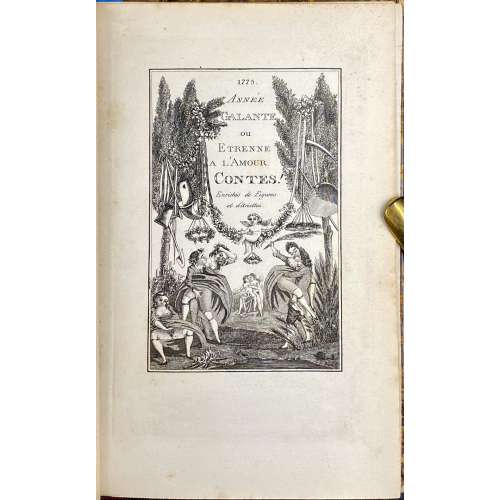 Single volume, 20 x 13 cm, quarter brown morocco over marbled boards tooled in gilt, spine with raised bands, gilt in compartments, and gilt lettering, marbled endpapers, printed on wove paper on recto with verso blank, collated 1-48; total 32 leaves, 11 torn off, 47,8 blanks, ; uneven pagination [1] 2-41 [4 blanks], plus engraved title-page and 12 engraved half-page plates with text, uncoloured, by Louis Jaugey (unsigned), one for each month. Title-page (engraved): vignette with lettering "1775. ANNÉE | GALANTE | OU | ETRENNE | A L'AMOUR | CONTES! | Enrichis de Figures | et d'Ariettes. ||" Catalogue raisonné: Dutel I: A-82. Catalogue Poulet-Malassis & ses amis description: № 68. [Auteur inconnu]. Année galante ou Etrenne à l’amour. Contes, enrichis de Figures et d’Ariees. [Vital Puissant, Bruxelles, 1876 ?] 1775. In-8, 3 .n.ch., 29 . imprimés au recto, chirés de 2 à 41, demi-chagrin brun, dos à nerfs orné, let doré sur les mors, tête et tranches jaspées (reliure ancienne). Illustrée de 13 planches dont l’une en frontispice par Louis Jaugey. Les figures sont à mi-page, une pour chaque mois. Contributors: Louis Jaugey (French, fl. 1871 – 1876) – artist. Vital Puissant (Belgian, 1835 – 1878) – publisher.
Single volume, 20 x 13 cm, quarter brown morocco over marbled boards tooled in gilt, spine with raised bands, gilt in compartments, and gilt lettering, marbled endpapers, printed on wove paper on recto with verso blank, collated 1-48; total 32 leaves, 11 torn off, 47,8 blanks, ; uneven pagination [1] 2-41 [4 blanks], plus engraved title-page and 12 engraved half-page plates with text, uncoloured, by Louis Jaugey (unsigned), one for each month. Title-page (engraved): vignette with lettering "1775. ANNÉE | GALANTE | OU | ETRENNE | A L'AMOUR | CONTES! | Enrichis de Figures | et d'Ariettes. ||" Catalogue raisonné: Dutel I: A-82. Catalogue Poulet-Malassis & ses amis description: № 68. [Auteur inconnu]. Année galante ou Etrenne à l’amour. Contes, enrichis de Figures et d’Ariees. [Vital Puissant, Bruxelles, 1876 ?] 1775. In-8, 3 .n.ch., 29 . imprimés au recto, chirés de 2 à 41, demi-chagrin brun, dos à nerfs orné, let doré sur les mors, tête et tranches jaspées (reliure ancienne). Illustrée de 13 planches dont l’une en frontispice par Louis Jaugey. Les figures sont à mi-page, une pour chaque mois. Contributors: Louis Jaugey (French, fl. 1871 – 1876) – artist. Vital Puissant (Belgian, 1835 – 1878) – publisher. -
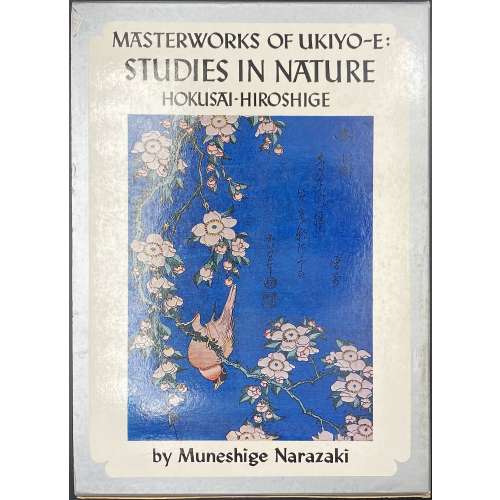 Hardcover volume from the series Masterworks of ukiyo-e, 26.3 x 19.2 cm, bound in unprimed canvas, red characters on black strip to front, red and black lettering to spine, tan flat endpapers, in a pictorial slipcase with series design (black lettering on silver spine); pp: [1-6]: h.t./frontis. (colour plate pasted in), t.p./imprint, contents/acknowledgements), 7-31 text, [32] blank, 33-96 (58 plates w/captions). Title-page (in frame): MASTERWORKS OF UKIYO-E | STUDIES IN NATURE | HOKUSAI-HIROSHIGE | by Muneshige Narazaki | Translated by John Bester | {publisher’s device} | KODANSHA INTERNATIONAL LTD. | Tokyo, Japan & Palo-Alto, Calif., U.S.A | {vertical, between rules 花鳥風月} || 花鳥風月 (Kachou Fugetsu) – beauties of nature. Series: Masterworks of ukiyo-e, № 11. Contributors: Muneshige Narazaki [楢崎 宗重] (Japanese, 1904 – 2001) – author. John Bester (British, 1927 – 2010) – translator. Katsushika Hokusai [葛飾 北斎] (Japanese, 1760 – 1849) – artist. Utagawa Hiroshige [歌川 広重] a.k.a. Andō Hiroshige [安藤 広重] (Japanese, 1797 – 1858) – artist.
Hardcover volume from the series Masterworks of ukiyo-e, 26.3 x 19.2 cm, bound in unprimed canvas, red characters on black strip to front, red and black lettering to spine, tan flat endpapers, in a pictorial slipcase with series design (black lettering on silver spine); pp: [1-6]: h.t./frontis. (colour plate pasted in), t.p./imprint, contents/acknowledgements), 7-31 text, [32] blank, 33-96 (58 plates w/captions). Title-page (in frame): MASTERWORKS OF UKIYO-E | STUDIES IN NATURE | HOKUSAI-HIROSHIGE | by Muneshige Narazaki | Translated by John Bester | {publisher’s device} | KODANSHA INTERNATIONAL LTD. | Tokyo, Japan & Palo-Alto, Calif., U.S.A | {vertical, between rules 花鳥風月} || 花鳥風月 (Kachou Fugetsu) – beauties of nature. Series: Masterworks of ukiyo-e, № 11. Contributors: Muneshige Narazaki [楢崎 宗重] (Japanese, 1904 – 2001) – author. John Bester (British, 1927 – 2010) – translator. Katsushika Hokusai [葛飾 北斎] (Japanese, 1760 – 1849) – artist. Utagawa Hiroshige [歌川 広重] a.k.a. Andō Hiroshige [安藤 広重] (Japanese, 1797 – 1858) – artist.


